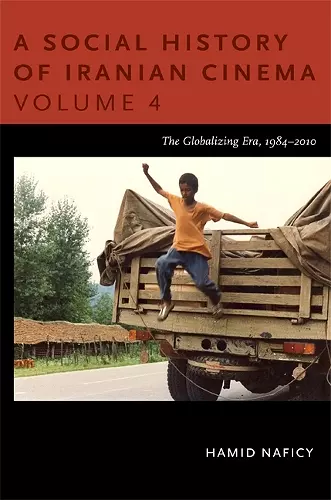A Social History of Iranian Cinema, Volume 4
The Globalizing Era, 1984–2010
Format:Hardback
Publisher:Duke University Press
Published:6th Nov '12
Currently unavailable, and unfortunately no date known when it will be back

In the fourth and final volume of A History of Iranian Cinema, Hamid Naficy looks at the extraordinary efflorescence in Iranian film and other visual media since the Islamic Revolution.Hamid Naficy is one of the world's leading authorities on Iranian film, and A Social History of Iranian Cinema is his magnum opus. Covering the late nineteenth century to the early twenty-first and addressing documentaries, popular genres, and art films, it explains Iran's peculiar cinematic production modes, as well as the role of cinema and media in shaping modernity and a modern national identity in Iran. This comprehensive social history unfolds across four volumes, each of which can be appreciated on its own.
The extraordinary efflorescence in Iranian film, TV, and the new media since the consolidation of the Islamic Revolution animates Volume 4. During this time, documentary films proliferated. Many filmmakers took as their subject the revolution and the bloody eight-year war with Iraq; others critiqued postrevolution society. The strong presence of women on screen and behind the camera led to a dynamic women's cinema. A dissident art-house cinema—involving some of the best Pahlavi-era new-wave directors and a younger generation of innovative postrevolution directors—placed Iranian cinema on the map of world cinemas, bringing prestige to Iranians at home and abroad. A struggle over cinema, media, culture, and, ultimately, the legitimacy of the Islamic Republic, emerged and intensified. The media became a contested site of public diplomacy as the Islamic Republic regime as well as foreign governments antagonistic to it sought to harness Iranian popular culture and media toward their own ends, within and outside of Iran. The broad international circulation of films made in Iran and its diaspora, the vast dispersion of media-savvy filmmakers abroad, and new filmmaking and communication technologies helped to globalize Iranian cinema.
A Social History of Iranian Cinema
Volume 1: The Artisanal Era, 1897–1941
Volume 2: The Industrializing Years, 1941–1978
Volume 3: The Islamicate Period, 1978–1984
Volume 4: The Globalizing Era, 1984–2010
"A Social History of Iranian Cinema is an extraordinary achievement, a scholarly, detailed work in which a massive amount of material is handled with the lightest touch. Yet it is Hamid Naficy's personal experience and investment that give this project a particular distinction. Only a skilled historian, one who is on the inside of his story, could convey so vividly the symbolic significance of cinema for twentieth-century Iran and its deep intertwining with national culture and politics."—Laura Mulvey, author of Death 24× a Second: Stillness and the Moving Image
"Hamid Naficy is already established as the doyen of historians, as well as critics, of Iranian cinema. Based on his deep understanding of modern Iranian political and social history, this detailed critical study of cinema in Iran since its debut more than a century ago is his crowning achievement. To say that it is a must-read for virtually all concerned with modern Iranian history, and not just cinema and the arts, is to state the obvious."—Homa Katouzian, author of The Persians: Ancient, Mediaeval and Modern Iran
"Hamid Naficy seamlessly brings together a century of Iran's cinematic history, marking its technological advancements and varying genres and storytelling techniques, and perceptively addressing its sociopolitical impact on the formation of Iran's national identity. A Social History of Iranian Cinema is essential reading not only for the cinephile interested in Iran's unique and rich cinematic history but also for anyone wanting a deeper understanding of the cataclysmic events and metamorphoses that have shaped Iran, from the pivotal Constitutional Revolution that ushered in the twentieth century, through the Islamic Revolution, and into the twenty-first century."—Shirin Neshat, visual artist, filmmaker, and director of the film Women Without Men
"This magisterial four-volume study of Iranian cinema will be the defining work on the topic for a long time to come. Situating film within its sociopolitical context, Hamid Naficy covers the period leading up to the Constitutional Revolution and continues after the Islamic Revolution, examining questions about modernity, globalization, Islam, and feminism along the way. A Social History of Iranian Cinema is a guide for our thinking about cinema and society and the ways that the creative expression of film should be examined as part of a wider engagement with social issues."—Annabelle Sreberny, coauthor of Blogistan: The Internet and Politics in Iran
“The major strength of the book lies in a vast array of information and examples with a picturesque description of life and society in Iran and cinema that has found numerous platforms all over the world. The scrupulousness with which these histories unfold and develop, coupled with the author’s profound understanding of the milieu, and its media and film, makes this book a must read for anyone interested in contemporary Iran and its extraordinary cinema.” -- Arezou Zalipour * Media International Australia *
“[A]n important intervention in Iranian film studies. Naficy has conducted significant research for them while providing new insights on and revisions of his earlier writings.” -- Pedram Partovi * Iranian Studies *
“The four volumes of A Social History of Iranian Cinema constitute a landmark achievement. . . . For students of Iranian cinema, I can think of no better place to begin than these four volumes. The sheer expansiveness of Naficy’s project is a testimony to the untold narratives, theoretical paradigms, and concepts waiting to be found in the ongoing history of Iranian cinema.” -- Sara Saljoughi * International Journal of Middle East Studies *
ISBN: 9780822348665
Dimensions: unknown
Weight: 1070g
664 pages